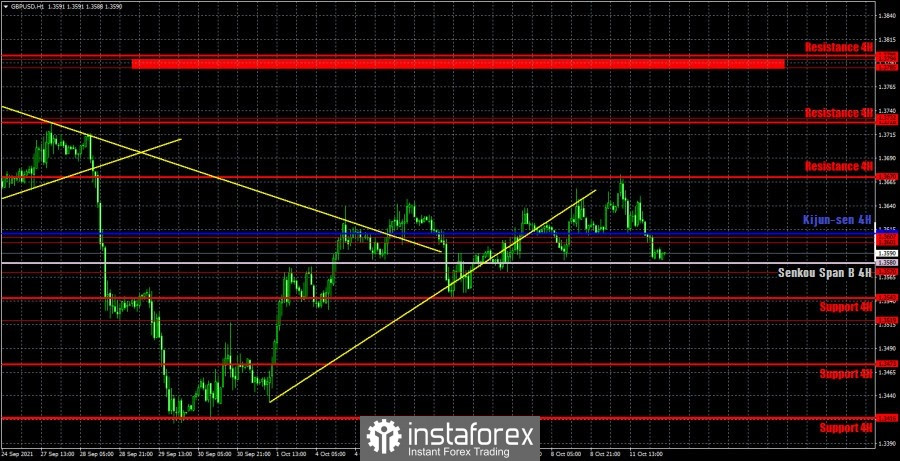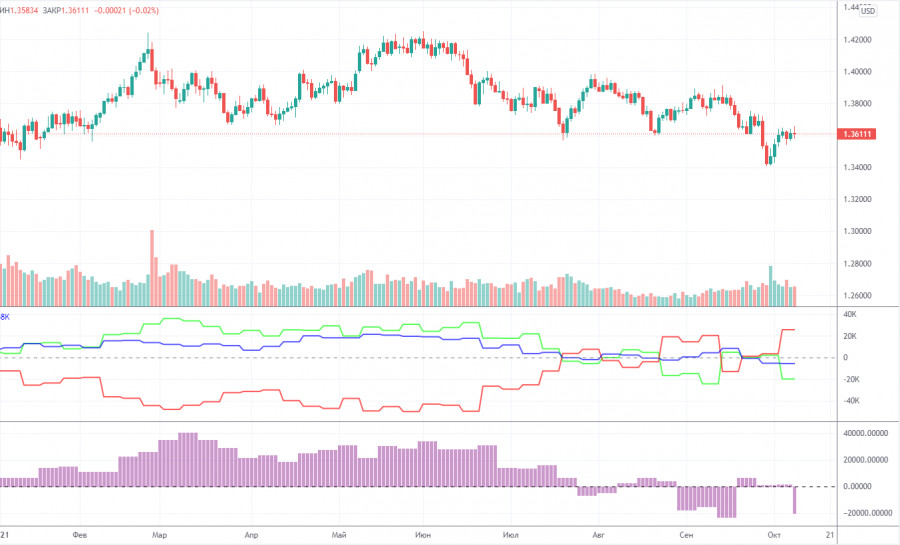
GBP/USD 5M

The GBP/USD pair traded slightly better than the EUR/USD pair on October 11, but it managed to extract even less dividends from this than in the case of the euro. The main problem is that the pair has not worked a single important level or line for the whole day. Thus, not a single sensible trading signal was generated. Therefore, traders did not have to open positions on the first trading day of the week. Macroeconomic reports were also not available in either the US or the UK. In the first half of the day, quotes grew more, and in the second, they fell even more. Thus, market participants have not decided on the direction of movement during the day. Recall that the technical and fundamental picture for the pound is now quite ambiguous on all timeframes. The upward movement seems to continue, but at the same time it is somehow too strained. The fundamental background now contains too many potentially important topics, but at the same time it is very difficult to say to which of them traders react and whether they react at all to at least something? After all, the volatility for the pound/dollar pair also leaves much to be desired. If 40-50 points a day is considered a low value for the euro currency, then for the pound, 60-70 is a low value. Yesterday the price went from a low to a high of 70 points. Of course, with 70 points of movement, it is quite possible to trade and earn. We only draw your attention to the fact that even six months ago, the normal daily volatility for the pair was 100-130 points. And so it was almost always, except for such periods of time as now.
GBP/USD 1H

The pound/dollar pair is trying to continue the upward trend on the hourly timeframe. But the upward trend line was already left behind, and it was not possible to settle above the level of 1.3641. Thus, at this time, a new round of correction has begun, while still within the upward trend. However, the pair's movement has recently been very difficult to work out on almost any timeframe, and the movement itself is more like a "fence". In case of a price rebound from the critical line, we can expect a renewed movement to the upside, but at the same time, we would like to draw your attention to the fact that Bollinger bands indicate a flat on the 4-hour TF. And in a flat, the lines of the Ichimoku indicator lose their strength, and the price can overcome them without much difficulty. It is not recommended to use the Ichimoku line as a source of signal in a flat. We distinguish the following important levels on October 12: 1.3519, 1.3570, 1.3601 - 1.3607, 1.3732. Senkou Span B (1.3580) and Kijun-sen (1.3610) lines can also be sources of signals (but there is a high probability that they are false now). It is recommended to set the Stop Loss level at breakeven when the price passes 20 points in the right direction. The Ichimoku indicator lines can move during the day, which should be taken into account when looking for trading signals. The UK is to publish data on unemployment, claims for unemployment benefits and wages on Tuesday. However, it is far from certain that such reports will be worked out by the markets. As we have already said, many reports, and much more important ones, are now ignored by market participants.
We also recommend that you familiarize yourself with the forecast and trading signals for the EUR/USD pair.
COT report

The mood of professional traders became much more bearish again during the last reporting week (September 28 - October 4). "Again" - not because it has been constantly increasing in recent weeks, but because traders could not decide what to do with the British pound. Therefore, their moods became bullish, then returned to being bearish. The last change was again in the direction of bears. Professional traders opened 12,000 sell contracts (shorts) and closed 10,000 buy contracts (longs) in a week. Thus, the net position of the "non-commercial" group decreased by 22,000 contracts at once. In the chart above, you can clearly see how the green line of the first indicator fell. We see the same effect with the second indicator, which displays changes in the net position only of non-commercial traders who are considered the most important and trend-forming group. Thus, the bearish mood now prevails, as in the case of the European currency. Technique is also talking about a very likely resumption of downward movement. However, looking at price changes over the past year and comparing them with Commitment of Traders (COT) reports, it becomes clear that not everything is so simple. Simply because the pound is still very weakly corrected against the global upward trend. For example, the peak value of the "non-commercial" net position over the last year was approximately 40,000. At the moment we have a peak minimum value of - 20,000. And the price is still in the same weak downward correction globally.
Explanations for the chart:
Support and Resistance Levels are the levels that serve as targets when buying or selling the pair. You can place Take Profit near these levels.
Kijun-sen and Senkou Span B lines are lines of the Ichimoku indicator transferred to the hourly timeframe from the 4-hour one.
Support and resistance areas are areas from which the price has repeatedly rebounded off.
Yellow lines are trend lines, trend channels and any other technical patterns.
Indicator 1 on the COT charts is the size of the net position of each category of traders.
Indicator 2 on the COT charts is the size of the net position for the non-commercial group.